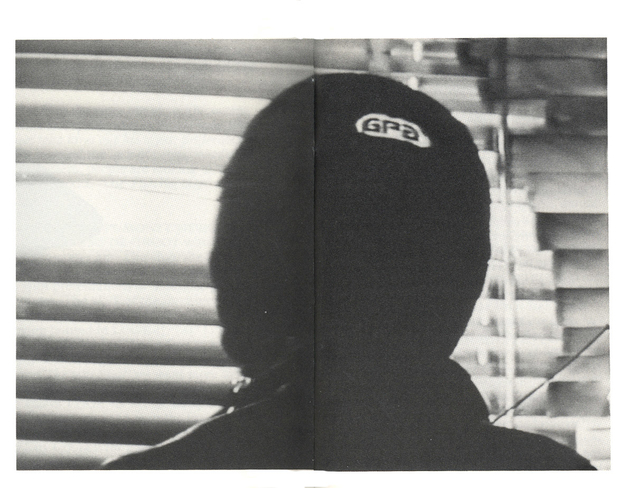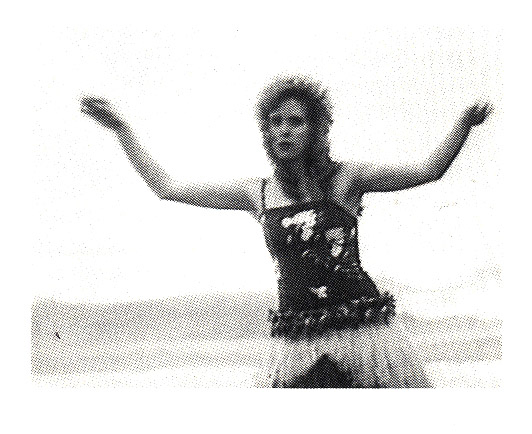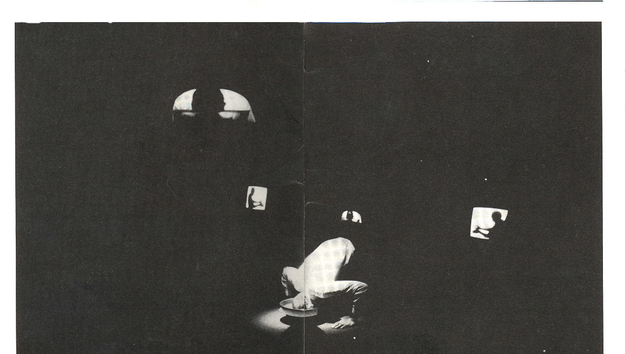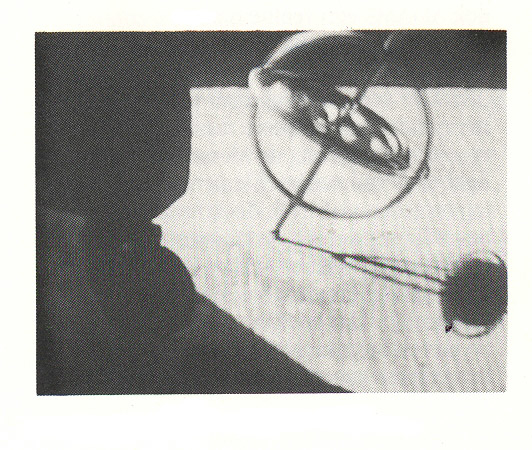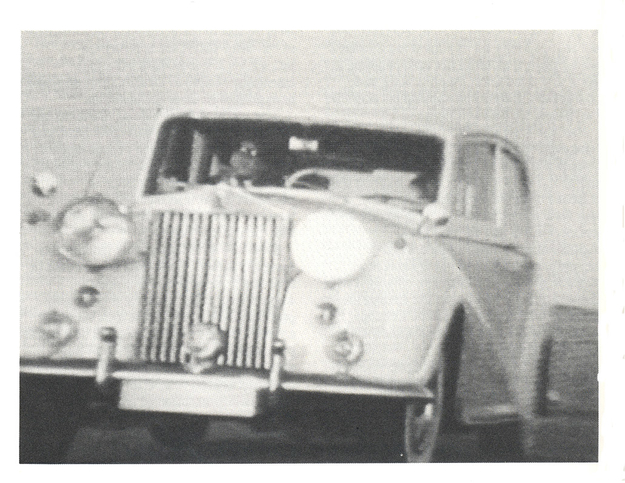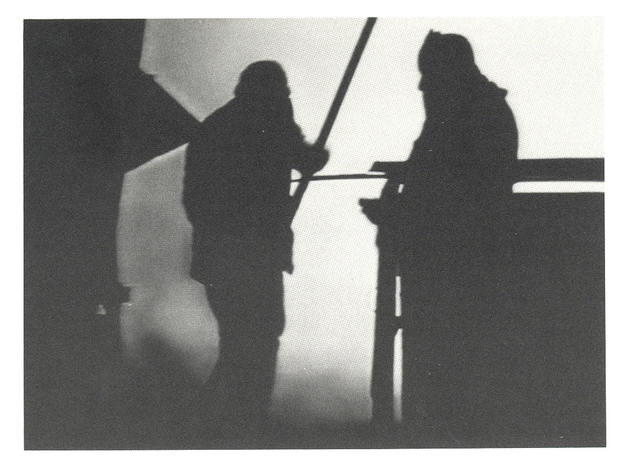The work of the video makers JOHN ADAMS (UK), JEAN CLAUDE RIGA (Belgium), BILL SEAMAN (USA), NIGEL ROLFE (Ireland), STEVE FAGIN (US) and GAD HOLLANDER (London) all reflected sources and motivations outside the usual conventions of video historicity. The diversity of these forms - these previous artistic incarnations - suggested that their videos were substantially different, both collectively and individually. In these authors works can be seen to be evolving a language better suited to its context, cognizant of a medium that is not painting, sculpture, performance or film but is nevertheless not exclusive of them.
Gad Hollander Background Music (Orphic) 1986
Watching their videos one is aware of modes of signification that, in one way or another, delineate a network of codes suggestive of a pre-historical textuality - the reference to some half-hidden process that could be conceived of as primitive. That is not to say that their work appears to be primitivistic (as early modernism) but rather that their work refers, at least obliquely, to some function of language more fundamental than the higher level codes that we are used to dealing with in normal communication. 1)
Primal codes
None of the artists dealt with here pretend to solutions regarding their individual, , although closely related, fields of inquiry. They all share an attitude that leads them to problematise the status of language in our culture. Each author explores the basic forms and structures of our dominant codes, deconstructing - through alternating convergences and divergences of information (for example STEVE FAGIN's use of rapidly shifting and seemingly disconnected scenario) - the forces that animate our communication and thus recognizing the orphic nature of their pursuits.2) For each of them the means of this activity, the process of codifying, are seen as ultimately dependent on these same processes of multiplication, ambiguity and opacity that are so problematic in the first instance. This is most apparent in BILL SEAMAN's work where language, and therefore the production of meaning, is seen to collapse in on itself as its tautological nature is unable to support the weight of its implications.3)
Steve Fagin The amazing Voyage of Gustave Flubert and Reymond Roussel 1986
It is perhaps in the work of GAD HOLLANDER, or not so much in his work but his evident background in poetry, that the initial signs allowing the critical eye to function become visible. Since THE BEAT POETS the forms of dissemination for poetry have multiplied into performance, film and television (amongst other media), not only introducing poetry to a broader audience but also giving cause to study the mechanics of their medium in its relationship with other media. In HOLLANDER's work we have a poet making video which, in appearance, has little to do with his poetic activity. However, it is in the decoding of the work that we find its roots.
Background Music (Orphic) is, in its very structure, its methodology of suggestion and association and its use of ambiguity leading to multiple readings, poetic in form. The devices HOLLANDER employs in his recreation of the interwoven stories of Wozzeck and Orpheus are poetic in the same sense that GOETHE's Faust was (or in contemporary fiction BORGES or CALVINO). In dealing with HOLLANDER's work, and that of the other artists written of here, it is tempting to apply a 'poetics of video'.
As noted in the Den Haag Festival catalogue, HOLLANDER applies all the usual motifs found in the various readings (and conclusions) of Wozzeck, in addition interweaving this fiction with the equally ambiguous (in the sense of multiple readings of equal value) myth of Orpheus in the underworld, all this deployed in the form of tableaux vivants. It is in the form of these tableaus and how they interrelate to construct the artist's intent, that is found powerful evocations of poetic form - not in any readily mapped manner (for example, image onto verse) but in how these tableaus function as icons that are cross-referenced in time and space, suggesting multiple patterns to be discerned and read.
^^Nigel Rolfe Island Stories (live-performance and video//
Although certain film makers (GODARD in Passion or FELLINI's 8 ½) have used similar techniques it is with video (its intimacy and programmability) that this method of meta-coding and organizing information begins to mature. The cinema screen functions as a 'field' on which our desires are played out, whilst the video monitor evokes the eye of the other, the eye of the author gazing at us, the viewer. More interestingly, we are given a degree of access to the process behind that electronic iris in a reversed form of the camera obscura.
This authorical presence is particularly evident in the work of STEVE FAGIN, whose The Amazing Voyage of Gustave Flaubert and Raymond Roussel carries us through labyrinthian possibilities regarding the relationship between author and reader. In this context the literary terms 'author/reader' rather than the artistic 'artist/viewer' seem to function best. The term viewer, in particular, is highly suggestive of the mode we adopt when receiving television or film, whereas there are aspects to the act of whatching a video which place it closer to the act of reading a book. For this reason I wish to suggest a somewhat different relationship between the two poles of communication.
FAGIN's use of video functions as a 'language machine', a term applied by the French philosopher MICHEL FOUCAULT to the text of ROUSSEL, in the manner that it causes multiple associations in simultaneous directions, adding weight and pre-deconstructing the process of signification. A rapidly paced work it nevertheless sustains detailed interest, as FAGIN's own script becomes entwined with both historically 'real' text (the lives of the two central characters) and the fictional author's fictions (an autobiography within an autobiography).
What FAGIN's work highlights is that in the position that the author attempts to place the reader is established the mode of language, the specific code or media. The author may deploy conventional means to achieve this position of power, however for video there are few existent conventions. On the whole the audience is uncomfortable with this situation as their place is not clearly defined - unless within the traditional codes of film, television, painting, sculpture of performance. The problem for the author here is to place their voice alongside that of their reader. The vector between author and reader is one of power - the power of seduction and rejection, absence and presence - the characteristics of the voyage.
Bill Seaman Telling Montions 1986
NIGEL ROLFE explores this vector of power with an incisive wit and physical presence through the specifics of social and personal politics and the ensuing contradictions found at their nexus. Island Stories deals, in the immediate, with the situation in Ireland, relating this to all political struggle (between one group and another, the author and their reader and between the author and the person who has become the author - in this last sense the work relates to the endurance performances of STUART BRISLEY and BRUCE MCLEAN). For ROLFE politics is essentially related to identity through power, as expressed in these relationships.
The use of video in Island Stories as one element in the work is well considered and finely tuned to each piece's requirements and yet eclectic as Ihe role of the displayed image shifts from performance to performance. It is in the connections between these short performance tableaux that the poetry developes.
ROLFE's work has a celtic rhythm and imagistic presence that, in a sense, could be read as a form of pre-verbal poetry, suggestive of tribal rituals and cleansing processes, as the performer took his place amongst the glowing monitors. The French philosopher JACQUES DERRIDA has argued that the text (in the form of highly ritualised actions or inscriptions) pre-dates verbal communication of a sufficiently sophisticaled quality to be called language, in oppostion to the antropologist CLAUDE LEVI-STRAUSS who believed that verbal communication was more primal.4)
Island Stories manages to produce a powerful presence with transparant readings deploying a mixture of simple iconic (video) images, elemental human actions (performance) and sound of an almost physical tangibility (music). NIGEL ROLFE admits to a fascination with prehistory (a time we define, as the word suggests, as pretextual) returning to it for inspiration in much of his work. One could see ROLFE's work as simulated or excavated prehistorical texts, as he searches in society and within the self for an archeology of signification and thus identity.
If NIGEL ROLFE's work seeks to establish a pre-verbal textuality then BILL SEAMAN attempts to reconstruct that point at which the division between the two occured. By using a limited number of video sequences, each subscripted with a letter of the alphabet, SEAMAN sets out to construct his language, his message. For him each sequence is similar to a child's alphabetical building block. Telling Motions, a visually splendid piece with a well integrated sound track, is composed of twenty six shorr sequences showing for instance a spinning top, a window, a human torso. Structured in three distinct parts SEAMAN initially introduces us to his alphabet - an abstract unitary system that requires organisation through set processes to attain meaning. The second and third parts seek to function at this higher level of language construction and signification.
However, it is at this point that the language fails itself. The reader is unable to decode, or concode, the data. It remains seductive but opaque, confusing although stimulating. SEAMAN develops the idea of a language collapsing in on itself. The idea that language only attains meaning in reference to itself and not through some absolute relationship with its referent. Related to this is the problem of the privacy of the code, its site specific character relative to its source, the author. The problem therefore is not so much as how to make something transparent but rather (due to the problematic relationship between the artist and the conventions of language) whether it is at all possible to transcend the code's essential opacity, its natural collapse into tautology.
John Adams Intellectual Properties 1985
It can be argued that it is through language that identity is constructed, both through the eyes of the other and in how we see ourselves in our actions (codes). A powerful sense of loss, even melancholy, permeates Telling Motions reinforcing this perception of incompletion, our inability to access either ourselves or our environment. This work functions as a beautiful mirror that would tell no lies regarding its beholder, evidencing the claustrophobia of our perceptions of ourselves and our things. SEAMAN's Telling Motions is language at its most fundamental, transcending arguments such as textuality versus verbalism, and touching on that which animates both.
If DERRIDA's position on the historicity of language, in reference to textuality and verbalism, is in opposition to the structuralist position, SEAMAN's tape suggests a third option. DERRIDA accuses ROLAND BARTHES of paradox in his celebration of the text but simultaneous denial of its precedence over the spoken word. In this DERRIDA is expressing his own preferences for the text. In SEAMAN's work the possibility emerges for a reconcilation as text and spoken word (parole and langue or langue and parole respectively, depending upon your position), image and music are all equalised, thus becoming secondary codes to a language process of a more primal aspect: an operation of signification that all these higher level codes refer back to, deconstructing the structuralist dependence (a dependence shared by DERRIDA, but in reverse) on oppositional (dialectical) logic.5)
That video makers such as SEAMAN, FAGIN and ROLFE are similarly touching on this vein buried deep in our culture is interesting in that the media they employ is of fairly recent invention - media central to LYOTARD's Post-Modern Condition. Strangely, video (a new technology) delivers the means to access or suggest processes considered as elemental or primal. Is it that video, due to some intrinsic quality in its nature or due to its historical position and context, is able to (in the hands of certain artists) open a fissure in the codes upon which we have constituted our culture.
The Dantesque netherworld imagery of JEAN CLAUDE RIGA's Ronde de Nuit - images of molten steel, steam and massive machinery - suggests what this fissure may look like if materialised in our artefacts, the expression of how we see ourselves.
Jean Claude Riga Ronde de Nuit 1985
Ronde de Nuit is a visual metaphor for the conceptual/psychological world we have created, the codes we have developed. Codes that have become machines (artefacts) that dwarf their inventors. RIGA's work deals with a number of interrelated issues regarding power, control, stratification and specialisation. That these readings could be applied to a large industrial complex (a symbol of a past age) and to the more abstract constructions of a post-industrial society suggests the fundamental similarities in the processes and forces that function through all forms of organisation - including the organisation of information as represented here in the medium of video. Such modes of organisation gain their power via complexity through reference to multiple readings that allow the system to function in a plurality of contexts and yet remain unassailable due to an inherent opacity - the essence (particularly evident in poetry) of ambiquity, the key to multiplicity and division.
These factors are managed to great effect by JOHN ADAMS in his work Intellectual Properties where his stated intent is to explore power: political power, economic power, the mass media and the temptation to create multiple fictions that nevertheless tally. ADAMS' world is one that is predicated on ambiguity and where that ambiguity can be exploited to give everyone a little of what they think they want whilst actually only giving them what you want to. That this function in art is constantly rewarded links the work to its own context and status whilst allowing it to look out on a world (of money, power and advertising) that is not really that different from its own. Through using the same elements in varying sequences ADAMS' creates a multiplicity of readings that reinforces the idea that society takes its forms from the dominant language structures that have informed the human intelligence since its origin.
In ADAMS' work it is the processes of power found in desire and gratification, fear and rejection, possession and dispossession and the ensuing paranoia/acceptance the subject must deal with that motivated his character. This in turn reflected on the viewer's relationship with the video maker and the medium of video within this dynamic.
Display
The problems of this rela,tionship between viewer and producer and the video are manifold and still largely unresolved. Although some artists are starting to adress these questions the nature of the context within which they place their work, and its effect upon the production and reception of that work, remains highly problematic. Video Festivals such as Den Haag and Bonn have evolved as did the museum and the gallery system, almost at random. The video festival is essentially a hybrid form, based upon the film festival and the art survey exhibition models. This tends to place video art as the bastard child of film and video without its own context.
Whilst some artists may be happy with this situation others must feel very uncomfortable in this context. (This could also be said of the audience). The positive aspects of video festivals are numerous, however one is left wondering why some artists place their work in a context that could be detrimental to their ideas. For these artists the need for an alternative mode of display is critical.
Whilst Den Haag, which is broad and cinema oriented, and Bonn, which is focused on artist's video within a gallery context, do represent alternatives, further thought to the diversity of the works and their equally diverse requirements needs to be given if video is to get the best possible reception.
Notes of the translator: 1) According to the Jacobson, a code is a limited set of signs or units (taken from a morphology) but also the procedures of their usage (their syntactic organization). Articulation of these two components enables us to produce messages.
2) Deconstruction in Derridian sense implies analysing two terms since long believed to be opposites (e.g. nature vs. culture), demonstrating that they are in fact two aspects of the same thing and eventually delining a term that incorporates both aspects (e.g. 'World').
3) This opacity results from the fact that the elements forming the code (the signs) are chosen arbitrarily and joined with a meaning that therfore is purely conventional and not motivated in any way by similarity between sign and meaning. In order to decode a massage one has to be aware of the meaning of each sign first.
4) According to Derrida writing must be considered merely as a metaphor for the concept of sign. That is why he claims that language has always been written language and even the first language ever, and that there is no clear distinction between written language and spoken language.
5) 'Langue' and 'parole' are an old couple here; according to Mario Pei 'langue' (a term coined by the Swiss Linguist Saussure) is the part of the language system which is inherited or institutioned, a complete and homogenous grammatical system used by an entire community, as against an individual's verbal message or 'parole' (Pei, Mario, Glossary of Linguistic Terminology, New York/ London, 1966, Columbia Univeristy Press). In fact 'parole' and 'langue' are equivalent to 'code' and 'message' that have been used supra.
If you'd like to quote something: Biggs, Simon. "The Primal Code." Mediamatic Magazine vol. 1 # 3 (1987).
Photos: Auke Bergsma for Kijkhuis
